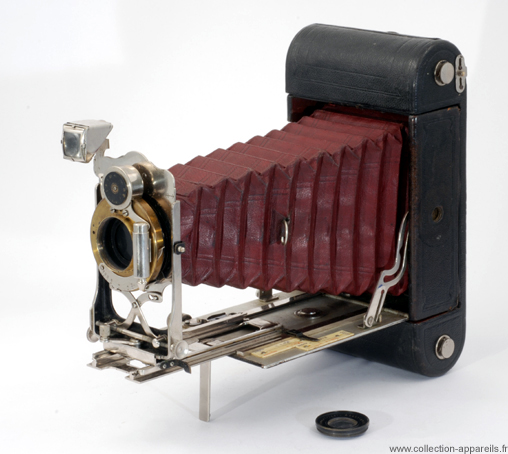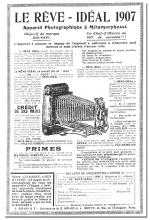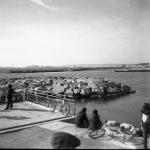|
Girard Le Rêve Ideal 1907 |
Manufactured or assembled in France from 1907 to (After) 1907.
Index of rarity in France: Rare (among non-specialized garage sales)
Inventory number: 11004
See the complete technical specifications
Chronology of cameras Girard
Traduction de Daniel C :
On this version, the lens is a Roussel, "Symetrical Anastigmat F:6,8" that may be split in two parts
The camera is double extension type and on the side of the bellow, we may notice the ring that allows to held the bellow when the camera is in single extension configuration. They are two distances scales, each one with double graduations for film and plate.
There is a screw driven rise, fall and shift capability. The shutter is a Baush et Lomb Automat It is pneumatic (1 2 5 25 50 100 B T).
On this camera, one of the two pneumatic attachment and the film winding key may be missing
The rise and fall system is very impressive and uses two cams arranged on a cross pattern and moving vertically.
Lens divisible into two to become a tele lens
The split lens
The optical glass has the good property to modify the direction of a light ray in a perfectly predictable way (according to the sinus rule) as a function of its refraction index and the incidence angle of the light ray.
Unfortunately, the refraction index of a given glass varies with the wave length of the light and, for a normal light ( not monochromatic) the refraction creates a dispersion, inducing the well known coloured fringes that can be observed with the bad instruments .
By combining skillfully some lens elements made of different glasses and calculating them accurately, the opticians may create photographic lens that minimize the optical aberrations for a defined use. A lens used for astronomy has not the same constraints as an ultra short focal lens or a lens for a microscope.
The doublet lens may produce an achromatic image for a reduced field and a small relative aperture, but shall show cushion or barrel type distortion according to the orientation of the curves and the location of the diaphragm...
Arranging two doublets symmetrically at each side of a diaphragm, we considerably reduce this distortion. The focal length is reduced of about an half and therefore, the relative aperture is nearly doubled.
This is the principle of the symmetrical lenses of the split configuration type but the doublet may be replaced by a triple or four lens groups in order to get rid of other kind of aberrations.
This principle may be extended to systems with the rear and front elements of different focal length. We create then the concept of lens “tool box”.
A tool box containing a diaphragm block, two rear lens blocks and two front lens blocks offers six different available focal lengths. Each one capable of providing a good image with a camera the bellow of which could be adapted to these different focal lengths.


Interesting links or bibliography :
 Lecture pour tous de 1907 |
Add a link or element of bibliography, a picture taken with this camera, a picture of box or an ads about this camera
Your photos taken with the same camera:
Cameras from Ebay France (Girard) (Uploaded each 3 hours)








